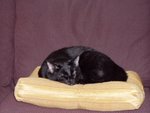On Thursday, Patrick and I went with my dad and stepmother to a lecture at National Geographic by archaelogist Michael Parker Pearson. Parker Pearson initially began digs at the areas around Stonehenge in an effort to prove or disprove his theory of its origin - that the builders conceived Stonehenge as a monument to the dead, the ancestors, whereas Woodhenge, a series of cocentric circles of tree trunks, was the departure point of the living. He speculated that people 4,500 years ago took their dead from Woodhenge and launched them down a nearby river, which flowed past Stonehenge, and that they might have carried their dead (certain select dead) up to Stonehenge. He's not sure if he's proved that theory, I think, but they did find Britain's largest neolithic village.
Hear Parker Pearson explain it himself. It was a fascinating talk, replete with the tiny mysteries that fill history. (Well, Patrick fell asleep, or at least flirted dangerously with sleep, but I thought it was interesting.) They found only three human bones in Woodhenge (among 80,000 animal bones), and one of them was a thigh bone with two arrow marks - one on the front, and one on the back. They identified what appear to be knee marks in front of a home's hearth. They suspect that a 1960s highway, which runs through Woodhenge, obscures a palacial neolithic house that held royalty or the like.

How do you handle that much yearning to know? How can one person discover so many unanswered questions and know that they'll never completely answer them, without totally losing it? To be interested in history, I think, you have to have an interest in humanity. And if you're interested in humanity, those little questions can't fail to move you (I think). So when every dig uncovers just a word, a comma, of another human story, how can you keep unearthing them?
Maybe I'm over-thinking it. Maybe I'm just not cut out to be an archaeologist. But I love dipping my toes in those pools of mysteries every once in a while. It's tantalizing. And then, life goes on.


3 comments:
Don't you find it odd that there were only 3 human bones compared to the 80,000 or so animal bones? This period in time intersects with the Small Mammal Era where squirrels, mice, rabbits and the like were arranged in a social hierarchy. They used Woodhedge as a playground and the shadows off the poles acted lines for an early tic-tac-toe. We wouldn't recognize the lines today, because a second smaller sun was needed to generate the vertical lines for the criss-cross pattern during dusk/dawn. That sun was later stolen by a sentient interstellar race that left behind a note of achievement on our moon: Haha.
Needless to say, tic-tac-toe was a brutal ritualistic game during the Small Mammal Era which most historians attribute to the oddity that now surrounds England and her culture.
Block of text crits you for 195433.
You die.
uggh.grgl.uhggh... ++General dying sounds++ I am definitely bested by your extensive knowledge of nonsense.
Post a Comment